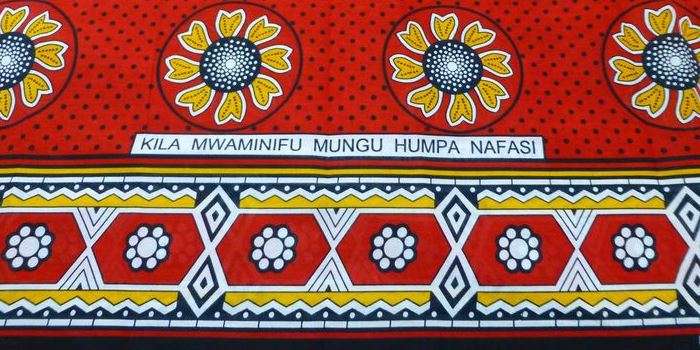7 Secrets Of Khangas and Feminity – In East Africa, and especially along the Swahili Coast, the khanga holds a special place: It is a rich piece of art and culture that is intricately woven into daily lives, from birth to death and in between. This rectangular piece of cotton cloth is comprised of a mji, or central design motif; a pindo, or patterned border; and a jina, or “name,” that bears a Swahili proverb, saying, or contemporary statement, usually printed in black bold capital letters against a white background along the edge between the motif and border.
And how East African women do, more than just wear the khanga; It is a mother’s swaddle for her new-born baby; an apron when one needs to clean the house; when one needs a towel; when one needs a curtain, a bed-spread, a scarf, a shawl, a handkerchief, something to lighten up a dull room or an outfit.
In a society where the woman’s voice is still not fully cultivated, the khanga has also become a place of endless imagination: a place to express and contest social norms. The khanga opens the channels for women to speak out, to clap back, to be heard, to love, to laugh, to pray, to return a gaze to the world. It becomes to a woman whatever she wants it to be: a voice that she wears around her, a message to the world, poetry, a shield. The khanga holds her with tenderness.
In gifting someone a khanga, or wearing it in their presence, a message arrives where it is intended. To a cheating lover, the khanga communicates subliminally that she knows. To the jealous friend, the khanga boasts, and to God, it prays. Where she goes, the message goes. A message in motion:
The kanga is a piece of East Africa’s heritage to call its own. We love its prints and behold the beauty of its patterns. Through the good and the wit of the sayings along its edges. How nostalgic are the memories it preserves? It is the women’s to own within the spaces they share, as intimate secrets get whispered; with the women’s hearty cackles rising above the steamy cups of spicy afternoon tea.
Here, the women create spaces that are safe and impenetrable; Spaces that belonged only to them. At the center of all this is the khanga, a piece of fabric with a motif and words that suggest something of a silent pushback, the saying something without saying it; Asking us to see it. To see a khanga is to see a woman as she wants to be seen. It is to see her choices, preferences, and moods—To see a khanga then, is to see a woman, return the gaze.
To some, it is called a leso, to others, it is the khanga; But whether leso or khanga, Oluokos Signature takes you through a whimsical journey of the Swahili culture as we explore this piece of cloth that has become uniquely associated with East African feminity. An item deemed fit both to be admired and to be put to use, perhaps embodying the ideal of high art:
#oluokoswithcommunities #oluokossignatureexperiences #GoBetterWithOluokos

Comment (0)